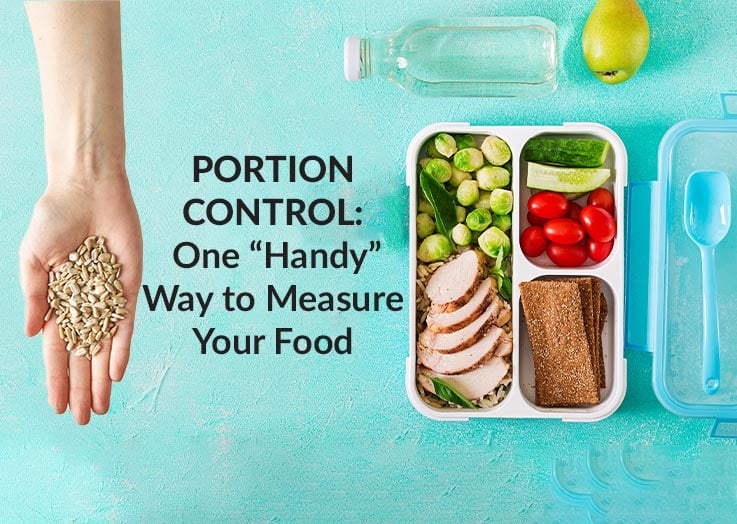Portion Control Guide: 1 “Handy” Way to Measure Your Food

I’m sure you’ve heard that losing weight is just a numbers game. Consume fewer calories than you burn, and you’ll lose weight. It’s just common sense. Now all you have to do is track how many calories you eat and how many you burn (often with some fancy app), practice portion control (i.e., measure your food), move your body, and you’ll effortlessly watch the body fat melt away.
The Problem with Calorie Counting
If only it were so easy… Unfortunately, losing weight is more complicated and nuanced than that. For example, weighing and measuring foods is not just time consuming and tedious, the whole calorie-counting thing is far from an exact science. Yep, even when you perfectly track every bite, calorie counts can be off by as much as 25%!
You see, the numbers on food labels and in calorie-counting apps are approximations, and there are many factors that can influence the number of calories available in a given food item (much less how many are actually absorbed). These include:
- Fiber content (especially resistant starches)
- Imprecise testing methods or analysis of foods
- Old data (recipes can change, and the nutritional database may take some time to update or the information may have always been off)
- Growing conditions, like climate, sunlight, soil, time harvested, etc.
- The animal’s diet (for milk, eggs, and meat, for example)
- Ripeness of vegetables and fruits
- Batch variations (even when foods are grown or prepared in a similar manner, there can be variations from one batch to the next)
- Storage time
- How the food was prepared and cooked
In other words, even with all of the information available, we can’t know exactly how many calories and nutrients are in a specific food. And we also don’t know exactly how much we’re absorbing and using vs. excreting (for example, due to individual variations in the gut microbiome).
So, no matter how exact we want to be, there’s just too much out of our control to get the calorie equation exactly right. In other words, forget calorie counting!
What About Portion Control?
Does that mean that portion control isn’t within your power? Fortunately, no. We can still practice portion control. (And we encourage you to do so). Best of all, practicing portion control can be a heck of a lot easier than weighing and measuring every meal with a food scale and dutifully journaling the results.
Better yet, it doesn’t take any technical know-how or fancy devices. In fact, you already have everything you need to easily practice portion control with you wherever you go! An easy portion control guide, it turns out, is right in the palm of your hand (or fist or thumb).
(We didn’t come up with this idea—Precision Nutrition did, but once we discovered how well it worked, we had to spread the message!)1
Handy Portion Control Guide
Here’s how simple it is:
- Use your palm for your protein portion.
- Use your fist for your veggie portion.
- Use your cupped hand for your carb portion.
- Use your thumb for added fat.
Eat three or four meals a day with your hand as your guide.

If you’re looking for just a bit more detail to this portion control guide:
- Protein. For foods like meat, fish, dairy, beans, and eggs, use a palm-sized portion. We recommend consuming a portion of protein with every meal. Generally speaking, a portion provides about 20 to 30 grams of protein. (Men and more active folks may need two portions per meal.)
- Veggies. For veggies like greens, cauliflower, broccoli, salads, etc., use a fist-sized portion (i.e., the same thickness and diameter). We recommend consuming one to two servings of veggies at each meal, although there’s really no limit per se.
- Carbs. For carb-dense foods like fruits, potatoes, whole grains, and starches, use a cupped hand portion. Generally speaking, carbohydrate intake should be inversely proportionate to body fat (i.e., more body fat, fewer carbs) and directly proportionate to activity levels (i.e., more active, more carbs). When trying to lose weight, women seem to fair well with half to one portion per meal while men typically do well with about one to two portions per meal.
- Fats. For healthy fats like oils (e.g., olive, macadamia, avocado, and coconut oils), butter/ghee, nuts, and seeds, use a thumb-sized portion. Speaking generally, women seem to fair well with half to one portion per meal while men typically do well with about one to two portions.
Yep, portion control is literally in the palm of your hand. Handy, isn’t it? Plus, it’s personalized to you. If you’re a bigger person, you likely have bigger hands. If you’re more petite, you’ll likely have smaller hands. And your hand size generally correlates well with your body size to help you easily eyeball your perfect, personalized portion.
“Handy” Portion Control Guide: Recap
Of course, each of us is different, and from here, it may be necessary to tweak the formula a bit. In addition to this handy portion control method, you may need to adjust up or down as you consider your hunger, fullness, goals, and progress. Say you start losing weight too quickly. You may want to add another cupped hand of carbs or another thumb of fat. If your body fat isn’t changing or you’ve reached a plateau, you may need to cut back on carbs by a half a cupped hand (and perhaps add another fist full of veggies). Likewise, if you find that your meals aren’t filling you up, then it might be time to add another fist full of vegetables or an additional half to one palm of protein.
The palm is a fantastically convenient, personalized starting point and eliminates the need to fuss with dutifully counting calories and grams of proteins, carbs, and fats for every meal of the day. And that’s something I think we can all raise a hand to.




 7 Signs Your Body is Seriously Low on Collagen (not just wrinkles)
7 Signs Your Body is Seriously Low on Collagen (not just wrinkles) Health Expert: "Turmeric Doesn't Work (unless...)"
Health Expert: "Turmeric Doesn't Work (unless...)" 3 Warning Signs Your Probiotic Supplement is a Total Waste
3 Warning Signs Your Probiotic Supplement is a Total Waste

